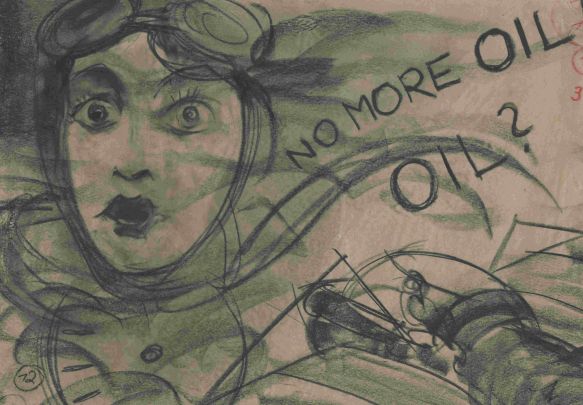
Storyboard drawing by Fritz Maurischat
Das Schiff der verlorenen Menschen (G 1929, directed by Maurice Tourneur)
Between Film and Art – Storyboards from Hitchcock to Spielberg
11.8. – 27.11.11
Exhibition
The storyboard is a cinematic working tool, positioned somewhere between artistic design and technical drawing. Similar to a comic strip, a storyboard represents the course of action that takes place in front of the camera, as well as the movements of the camera itself in the form of individually drawn images. In this way, it makes the testing and the dramaturgical revisions to the narrative course of a film’s story possible.
A storyboard allows insights into the artistic conception of a film, while simultaneously developing its own independent, aesthetic attraction. The spectrum of techniques with which the exhibited storyboards were realized, spans from delicate, monochrome works in graphite and Indian ink to tremendous bursts of color carried out in colored pencils and felt-tip pens, chalk and watercolor. Although the storyboard is an art form that comes close to the classic sketch with its centuries-old tradition, it has nevertheless remained nearly undiscovered within a museum context until now.
The term »storyboard« is presumably a coinage from the Walt Disney Studios, in which individual drawings were actually pinned to a corkboard. Storyboards were increasingly used in Hollywood by the end of the 1930s, when film productions became more extensive and costlier. Today, the names of the illustrators are often unknown.
Each of the storyboard drawings in the exhibition will be juxtaposed to the film sequences to which they refer, as well as to works by internationally known artists, whose aesthetics or conceptions share a connection with them. In this synoptic presentation it becomes apparent just how much the visual languages used by art and film have inspired and influenced one another.
The Storyboard in Germany
The first storyboards were created in the 1920s, when cameramen, set designers and directors began to sketch motion picture sequences in preparation for filming. One of the earliest storyboards in the history of film was created in Germany, when Fritz Maurischat, together with the director Frank Wisbar, developed the so-called »paper film« for Im Bann des Eulenspiegels (GER, 1932). He mounted 296 drawings to a 75 meter-long strip of paper, next to which were placed dialogues, directorial remarks, as well as notes for the camera takes and for the music in separate columns. In this way, the director, who was still inexperienced at the time, could practice cost-saving filmmaking on paper.
A few years later, the set designer Robert Herlth worked with a similar tool during production of Der Herrscher (GER, 1937). He ordered an abundant stack of drawings mounted on large-scale cardboard, marking each of them with excerpts and dialogues from the film script. This technique was taken up once again at DEFA in the late 1940s. Since the 1960s, the scenographer Alfred Hirschmeier, in particular, used so-called “optische Drehbücher” (visual film scripts) in which he also noted camera perspectives and directorial remarks. Even today, filmmakers such as Wim Wenders, Chris Kraus and Tom Tykwer still use storyboards for their groundwork, frequently in combination with drawings made by hand and through computer software.



